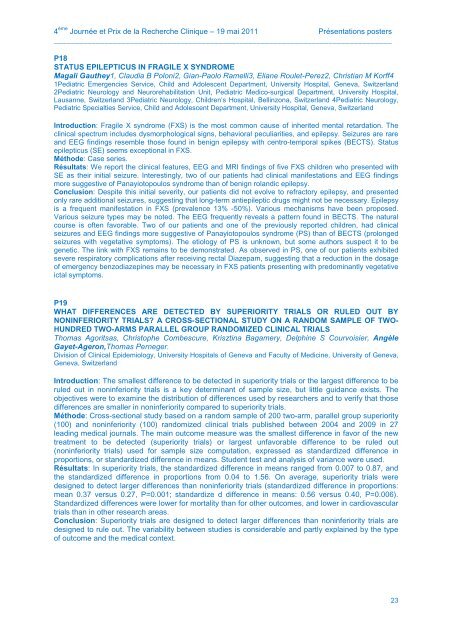Programme final et Recueil des résumés - Centre de recherche ...
Programme final et Recueil des résumés - Centre de recherche ...
Programme final et Recueil des résumés - Centre de recherche ...
You also want an ePaper? Increase the reach of your titles
YUMPU automatically turns print PDFs into web optimized ePapers that Google loves.
4 ème Journée <strong>et</strong> Prix <strong>de</strong> la Recherche Clinique – 19 mai 2011 Présentations posters<br />
________________________________________________________________________________<br />
P18<br />
STATUS EPILEPTICUS IN FRAGILE X SYNDROME<br />
Magali Gauthey1, Claudia B Poloni2, Gian-Paolo Ramelli3, Eliane Roul<strong>et</strong>-Perez2, Christian M Korff4<br />
1Pediatric Emergencies Service, Child and Adolescent Department, University Hospital, Geneva, Switzerland<br />
2Pediatric Neurology and Neurorehabilitation Unit, Pediatric Medico-surgical Department, University Hospital,<br />
Lausanne, Switzerland 3Pediatric Neurology, Children’s Hospital, Bellinzona, Switzerland 4Pediatric Neurology,<br />
Pediatric Specialties Service, Child and Adolescent Department, University Hospital, Geneva, Switzerland<br />
Introduction: Fragile X syndrome (FXS) is the most common cause of inherited mental r<strong>et</strong>ardation. The<br />
clinical spectrum inclu<strong><strong>de</strong>s</strong> dysmorphological signs, behavioral peculiarities, and epilepsy. Seizures are rare<br />
and EEG findings resemble those found in benign epilepsy with centro-temporal spikes (BECTS). Status<br />
epilepticus (SE) seems exceptional in FXS.<br />
Métho<strong>de</strong>: Case series.<br />
Résultats: We report the clinical features, EEG and MRI findings of five FXS children who presented with<br />
SE as their initial seizure. Interestingly, two of our patients had clinical manifestations and EEG findings<br />
more suggestive of Panayiotopoulos syndrome than of benign rolandic epilepsy.<br />
Conclusion: Despite this initial severity, our patients did not evolve to refractory epilepsy, and presented<br />
only rare additional seizures, suggesting that long-term antiepileptic drugs might not be necessary. Epilepsy<br />
is a frequent manifestation in FXS (prevalence 13% -50%). Various mechanisms have been proposed.<br />
Various seizure types may be noted. The EEG frequently reveals a pattern found in BECTS. The natural<br />
course is often favorable. Two of our patients and one of the previously reported children, had clinical<br />
seizures and EEG findings more suggestive of Panayiotopoulos syndrome (PS) than of BECTS (prolonged<br />
seizures with veg<strong>et</strong>ative symptoms). The <strong>et</strong>iology of PS is unknown, but some authors suspect it to be<br />
gen<strong>et</strong>ic. The link with FXS remains to be <strong>de</strong>monstrated. As observed in PS, one of our patients exhibited<br />
severe respiratory complications after receiving rectal Diazepam, suggesting that a reduction in the dosage<br />
of emergency benzodiazepines may be necessary in FXS patients presenting with predominantly veg<strong>et</strong>ative<br />
ictal symptoms.<br />
P19<br />
WHAT DIFFERENCES ARE DETECTED BY SUPERIORITY TRIALS OR RULED OUT BY<br />
NONINFERIORITY TRIALS? A CROSS-SECTIONAL STUDY ON A RANDOM SAMPLE OF TWO-<br />
HUNDRED TWO-ARMS PARALLEL GROUP RANDOMIZED CLINICAL TRIALS<br />
Thomas Agoritsas, Christophe Combescure, Krisztina Bagamery, Delphine S Courvoisier, Angèle<br />
Gay<strong>et</strong>-Ageron,Thomas Perneger.<br />
Division of Clinical Epi<strong>de</strong>miology, University Hospitals of Geneva and Faculty of Medicine, University of Geneva,<br />
Geneva, Switzerland<br />
Introduction: The smallest difference to be d<strong>et</strong>ected in superiority trials or the largest difference to be<br />
ruled out in noninferiority trials is a key d<strong>et</strong>erminant of sample size, but little guidance exists. The<br />
objectives were to examine the distribution of differences used by researchers and to verify that those<br />
differences are smaller in noninferiority compared to superiority trials.<br />
Métho<strong>de</strong>: Cross-sectional study based on a random sample of 200 two-arm, parallel group superiority<br />
(100) and noninferiority (100) randomized clinical trials published b<strong>et</strong>ween 2004 and 2009 in 27<br />
leading medical journals. The main outcome measure was the smallest difference in favor of the new<br />
treatment to be d<strong>et</strong>ected (superiority trials) or largest unfavorable difference to be ruled out<br />
(noninferiority trials) used for sample size computation, expressed as standardized difference in<br />
proportions, or standardized difference in means. Stu<strong>de</strong>nt test and analysis of variance were used.<br />
Résultats: In superiority trials, the standardized difference in means ranged from 0.007 to 0.87, and<br />
the standardized difference in proportions from 0.04 to 1.56. On average, superiority trials were<br />
<strong><strong>de</strong>s</strong>igned to d<strong>et</strong>ect larger differences than noninferiority trials (standardized difference in proportions:<br />
mean 0.37 versus 0.27, P=0.001; standardize d difference in means: 0.56 versus 0.40, P=0.006).<br />
Standardized differences were lower for mortality than for other outcomes, and lower in cardiovascular<br />
trials than in other research areas.<br />
Conclusion: Superiority trials are <strong><strong>de</strong>s</strong>igned to d<strong>et</strong>ect larger differences than noninferiority trials are<br />
<strong><strong>de</strong>s</strong>igned to rule out. The variability b<strong>et</strong>ween studies is consi<strong>de</strong>rable and partly explained by the type<br />
of outcome and the medical context.<br />
23






